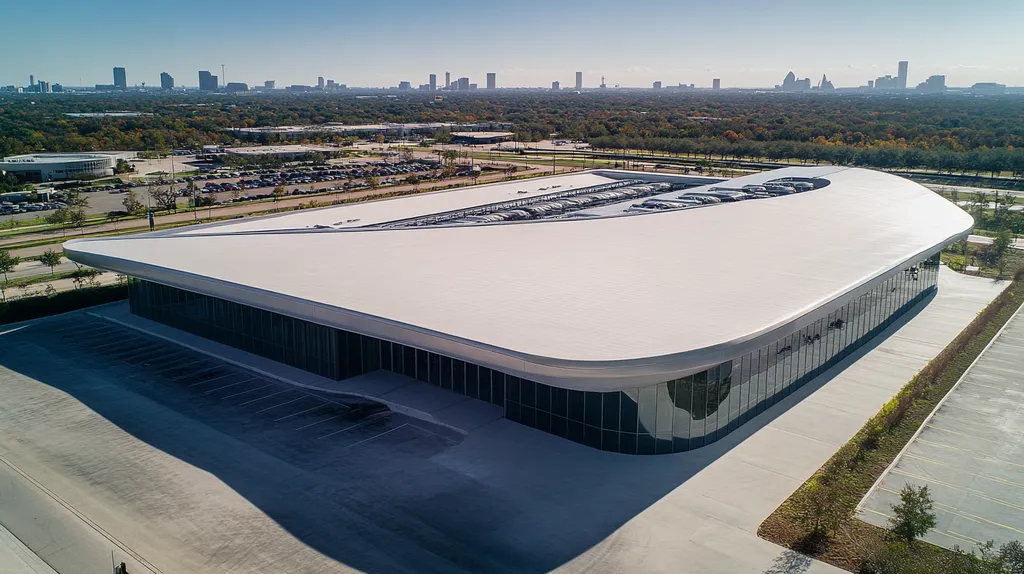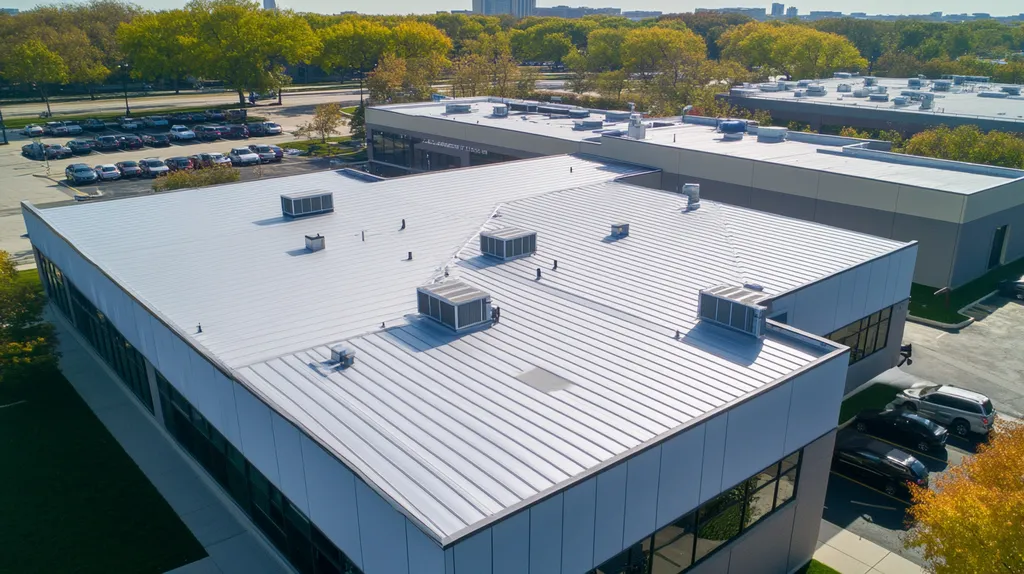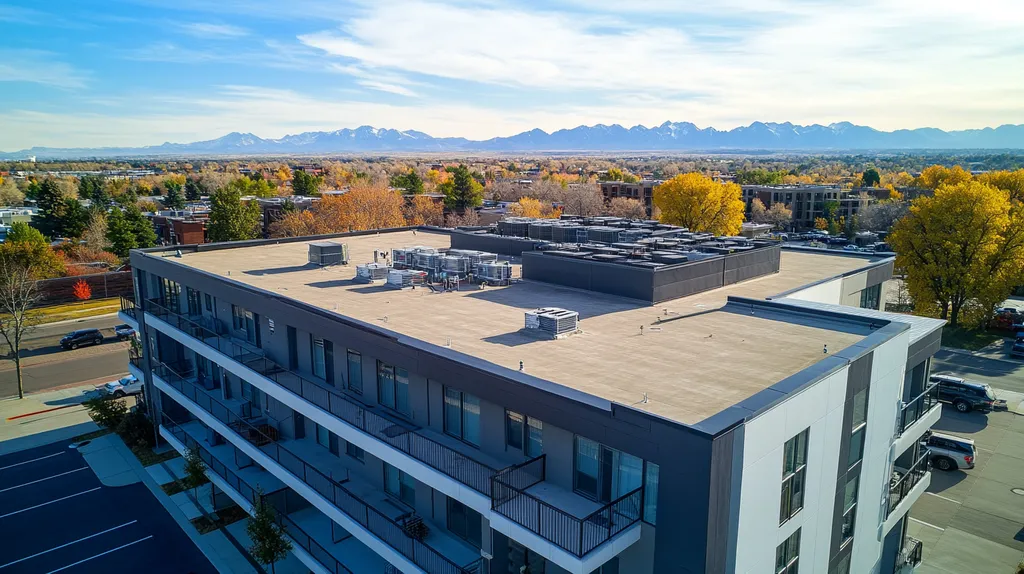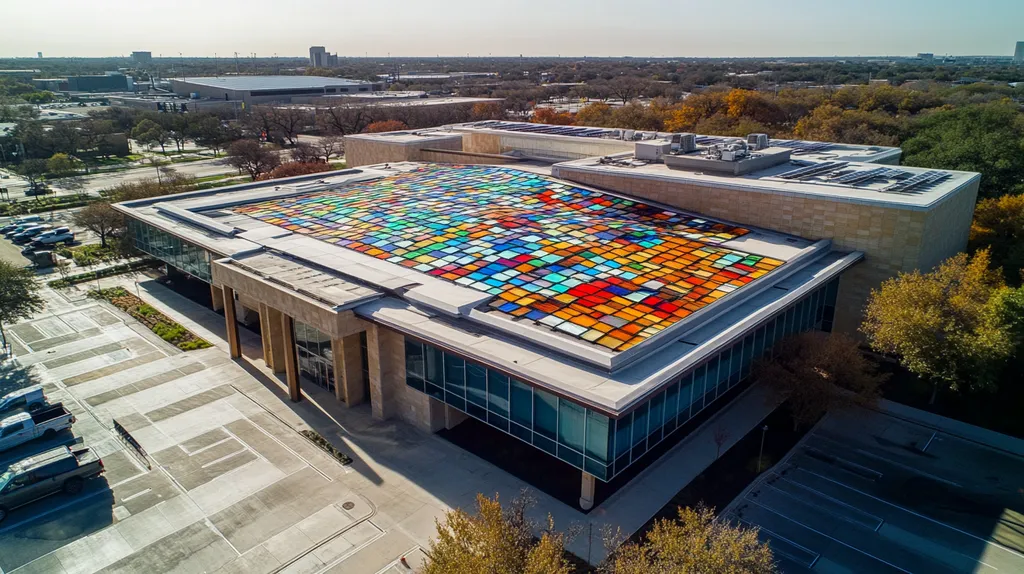Poor roof ventilation costs commercial buildings up to 30% more in annual energy expenses, yet many facility managers overlook this critical system. Recent industry studies show that optimized ventilation can reduce cooling costs by up to 20% while extending roof lifespan.
From performance factors and financial considerations to compliance requirements and risk management, proper ventilation impacts every aspect of facility operations.
This comprehensive guide provides facility managers with actionable solutions for evaluating, maintaining and upgrading commercial roof ventilation to maximize energy efficiency and minimize operational costs.
SECTION 1: PERFORMANCE FACTORS
Proper roof ventilation is not just an optional upgrade; it’s a critical strategy to control energy usage in commercial buildings. Inadequate ventilation can inflate energy expenses, with research indicating that as much as 30% of a facility’s overall energy consumption is linked to poor airflow. For facility managers, grasping how ventilation affects attic temperature and humidity, in addition to overall airflow, is vital for reducing operational costs and enhancing the comfort of building occupants.
Ventilation Impact on Energy Use
Effective ventilation systems are essential for maintaining comfortable indoor temperatures. Without sufficient airflow, heat can build up in attics, significantly increasing reliance on air conditioning systems. This surge in demand can cause energy expenses to soar, particularly during the scorching summer months.
Interestingly, facilities equipped with optimized ventilation have been shown to lower cooling costs by as much as 20%. This not only translates to immediate savings but also supports more sustainable operations.
Additionally, good ventilation prevents excessive heat accumulation, thereby extending the lifespan of roofing materials and minimizing maintenance costs, which is beneficial for budget management.
Implementing the right ventilation adjustments can lead to noticeable improvements, giving facility managers the insights needed to reduce energy usage and boost overall comfort.
Key Action Items
Attic Temperature and Humidity Control
Maintaining the right temperature in attics is critical for a building’s long-term health. Excessively hot attics can accelerate the deterioration of roofing materials and create an environment for mold growth.
Proper ventilation effectively stabilizes attic climates, preventing thermal shock that can occur with dramatic temperature swings.
Humidity control is equally important, as excessive moisture can result in condensation, inviting mold and decay. Adequate ventilation in attics can manage humidity levels, safeguarding both the roof structure and its occupants.
In short, ensuring that attics are properly ventilated enhances overall building performance and extends the life of the roofing system.
Key Action Items
Airflow Balance and Quality
Effective ventilation depends significantly on balanced airflow. An imbalance can cause certain areas to overheat while others remain cold, leading to discomfort for building occupants and increased energy expenses.
Ensuring that airflow quality is optimal is crucial, as stagnant air can degrade indoor air quality. Enhancing ventilation can reduce the presence of airborne pollutants and create a healthier indoor atmosphere.
By carefully designing airflow patterns, facility managers can ensure optimal circulation throughout the building, resulting in a more comfortable and productive work environment.
In conclusion, managing airflow balance and quality is essential for improving both energy efficiency and tenant satisfaction.
Key Action Items
SECTION 2: FINANCIAL CONSIDERATIONS
Effective roof ventilation represents more than just a safety measure; it is a crucial financial decision for facility managers. When ventilation systems fall short, energy costs can skyrocket, leading to significant losses over time. The U.S. Department of Energy estimates that improper ventilation can boost energy expenses by as much as 30%. Grasping the financial impacts of ventilation systems and their upkeep is essential for smart budgeting and planning.
Energy Savings through Ventilation
Investing in a high-quality ventilation system can produce impressive energy savings. A well-ventilated roof decreases the burden on cooling systems by reducing heat buildup, leading to as much as 20% savings on annual cooling costs. This drop in expenses directly benefits the facility’s financial health.
Optimized ventilation also enhances air quality, promoting a healthier work environment. Improved air quality can boost employee productivity and lead to fewer sick days and lower turnover, translating to additional cost savings for the facility.
With rising energy prices, the need for energy-efficient ventilation is urgent. Facility managers must assess the long-term savings potential of these systems. Investing in energy efficiency not only curtails operating costs but can also elevate the property’s market value.
Key Action Items
Cost of Ventilation System Maintenance
While the initial investment in a ventilation system can be significant, ongoing maintenance costs are equally important to consider. Regular upkeep is vital; neglecting routine maintenance can lead to costly repairs and replacements over time. Consistent monitoring of the ventilation system can prevent breakdowns that could disrupt operations.
For example, a poorly maintained rooftop unit can trap moisture, risking roof damage and driving up repair costs. Regular maintenance helps ensure that ventilation systems operate efficiently and have a prolonged lifespan.
Facility managers need to allocate budget for ongoing maintenance. This strategic investment shields against unplanned failures and heightens the efficiency of the ventilation system, contributing to better energy management.
Key Action Items
ROI on Ventilation Upgrades
While upgrading ventilation systems may seem daunting due to upfront expenses, the return on investment often makes it worthwhile. Facility managers frequently see a significant improvement in energy efficiency after implementing upgrades, often enjoying a payback period of only 3 to 5 years.
Additionally, enhanced ventilation can positively influence property valuation. Efficient ventilation systems signal lower operating costs and better indoor environments to prospective buyers or tenants, making upgraded properties more attractive in the market.
To accurately evaluate the ROI of ventilation investments, facility managers should consider both direct energy savings and the indirect advantages, like improved tenant satisfaction. Careful planning and assessment can lead to substantial long-term financial benefits.
Key Action Items
SECTION 3: COMPLIANCE REQUIREMENTS
Compliance with ventilation regulations is not merely a legal formality; it’s vital for enhancing energy efficiency and indoor air quality. Facility managers must navigate a intricate web of local codes, national standards, and energy efficiency regulations. Non-compliance can result in hefty fines, higher energy costs, and potential health risks for occupants. Understanding these requirements is critical for ensuring that ventilation systems are both effective and compliant.
Meeting Local Ventilation Codes
Local building codes set specific ventilation requirements tailored to factors such as building size and occupancy type. These codes are designed to promote health and safety by ensuring a consistent flow of fresh air in commercial spaces. For example, restaurants typically face stricter regulations than office buildings due to their higher occupancy rates.
Not adhering to these codes can result in steep fines or even facility shutdowns until compliance is achieved. Facility managers must stay informed about these regulations when designing, installing, and maintaining their roof ventilation systems, and collaborating with local authorities can provide crucial guidance.
Regular inspections and documentation play key roles in ensuring compliance and maintaining operational efficiency. By consistently adhering to local regulations, facility managers create safer environments while protecting their building investments. It’s essential to verify the latest local codes before implementing any ventilation changes to avoid costly retrofitting or legal issues in the future.
Key Action Items
Compliance with ASHRAE Standards
The American Society of Heating, Refrigerating and Air-Conditioning Engineers (ASHRAE) sets the benchmark for ventilation requirements in commercial settings. Guidelines such as ASHRAE 62.1 outline minimum ventilation rates to ensure acceptable indoor air quality. Complying with these standards is not just a best practice but often a regulatory necessity.
ASHRAE also highlights the need for balanced ventilation systems to mitigate pressurization issues. If ventilation systems are unbalanced, it can lead to moisture accumulation and elevated energy use, which ultimately compromises operational efficiency.
Facility managers should routinely compare their systems against ASHRAE standards to maintain compliance. Regular testing and adjustments can enhance energy performance and air quality significantly. Fostering an understanding of these standards among staff can cultivate a culture of compliance and responsibility.
Key Action Items
Adhering to Energy Efficiency Regulations
Energy efficiency regulations, including the Energy Policy Act and various state mandates, significantly influence ventilation practices. These regulations encourage methods that minimize energy consumption while ensuring adequate indoor air quality. Non-compliance can lead to substantial fines and loss of energy incentives.
Incorporating energy-efficient ventilation technologies, like variable speed fans or demand-controlled ventilation, can drastically lower energy use. These systems tailor airflow based on real-time occupancy, reducing waste and optimizing performance.
Facility managers must stay updated on evolving energy efficiency regulations to ensure compliance. Regular training and evaluations help staff effectively implement energy-saving practices. Additionally, meticulous record-keeping of energy usage can expose trends and identify improvement opportunities.
Key Action Items
SECTION 4: RISK MANAGEMENT
Neglecting effective roof ventilation poses serious risks to commercial properties. From moisture accumulation leading to costly damage, to ice dams jeopardizing structural integrity, and ventilation system failures disrupting daily operations, the stakes are high. Addressing these risks proactively is essential for preserving assets and ensuring smooth operational function.
Preventing Moisture-Related Damage
Moisture trapped beneath roofing membranes can create severe issues, such as mold growth and structural rot. These problems not only threaten the integrity of the roof but can also compromise indoor air quality, affecting tenant health. Facility managers need to prioritize ventilation systems that effectively remove humid air and maintain airflow.
Regular inspections of ducts and exhaust systems are crucial. Clogs or barriers can trap moisture, leading to short- and long-term damage. Establishing a proactive maintenance plan helps to uncover and rectify these issues before they escalate.
Incorporating vapor barriers into roofing can further help manage moisture. These materials are essential for controlling humidity inside the building, reducing the likelihood of costly repairs. Additionally, installing humidity sensors can provide real-time data to flag dangerous moisture levels, prompting timely interventions.
Key Action Items
Reducing Ice Dams and Winter Risks
Ice dams present a significant risk to commercial roofs, particularly in colder climates. Warm air escaping from a building melts snow on the roof, which then refreezes at the edges, creating ice buildup. This situation can lead to leaks and extensive damage.
Maintaining proper ventilation is vital in preventing ice dams. A well-ventilated roof regulates temperatures, minimizing the potential for snow melt. Facility managers should focus on ensuring adequate insulation and properly balanced ventilation systems.
Additionally, installing heat cables can be an effective solution to combat ice formation. These cables provide localized heat to keep critical areas free of ice. Routine snow removal from roofs further prevents the formation of ice dams, thereby reducing winter-related risks.
Key Action Items
Mitigating Ventilation System Failures
Reliable ventilation systems are crucial for maintaining roof health. A failure can lead to poor air quality, heightened energy use, and tenant frustration. Facility managers must prioritize regular maintenance checks of vents, fans, and filters to ensure optimal performance.
Implementing advanced monitoring systems helps track ventilation efficiency in real time. These tools can signal managers of any irregularities before they escalate into severe issues. Early detection is vital in addressing potential failures.
Training staff in routine maintenance practices is essential for fostering an informed team. Awareness of the importance of ventilation can facilitate quicker issue identification, reducing risks associated with system failures. Finally, investing in high-quality materials boosts the durability of ventilation systems, yielding a stronger return on investment.
Key Action Items
SECTION 5: OPERATIONAL PROCEDURES
Maintaining effective roof ventilation is essential not just for energy efficiency, but also for safeguarding property value and occupant wellbeing. Inefficient systems can lead to skyrocketing energy costs, increased risk of roof damage, and poor indoor air quality. With studies indicating that optimized ventilation can reduce cooling costs by as much as 30%, it is imperative for facility managers to adopt stringent operational procedures to ensure that ventilation systems operate effectively.
Regular Ventilation System Checks
Routine ventilation system checks are vital to ensuring optimal roof performance. These inspections help identify potential issues such as blockages or leaks that can disrupt airflow. It is advisable to schedule these checks at least twice a year.
Creating a comprehensive inspection checklist is beneficial for thorough evaluations. Check that exhaust fans are functioning efficiently and that intake vents remain unobstructed. Advanced monitoring systems can deliver real-time data and enhance performance tracking.
Documenting inspection findings and actions taken is crucial. This creates a historical record for identifying patterns over time and informing future maintenance. Overlooking regular checks can lead to significant operational costs and early deterioration of the roof.
Key Action Items
Implementing Balanced Ventilation Designs
Adopting a balanced ventilation design is crucial for optimizing airflow and improving energy efficiency. This design ensures that the intake and exhaust of air are equal, preventing pressure imbalances that can create unwanted air leaks or moisture issues.
Integrating both passive and mechanical ventilation systems can amplify roof performance. For instance, using strategically placed intake vents combined with powered exhaust systems can significantly enhance airflow, often leading to considerable energy savings.
Energy modeling techniques can assist facility managers in determining the optimal configuration tailored to specific roof designs and regional climates. Engaging roofing professionals during early design phases can ensure better long-term performance and compliance with regulations.
Key Action Items
Training Staff on Roof Ventilation
Training staff is essential to maintain effective roof ventilation systems. Well-informed personnel are more equipped to identify ventilation issues promptly, minimizing damage and costly repairs.
Implementing comprehensive training modules on the significance of roof ventilation and operational best practices will provide staff with necessary skills. This education should cover basic inspections and establish clear points of contact for specialist assistance.
Ongoing training sessions help keep staff updated on the latest technologies and best practices in ventilation. Establishing reliable communication channels for reporting ventilation concerns enhances overall system management, contributing to healthier indoor environments.
Key Action Items
SECTION 5: OPERATIONAL PROCEDURES
Maintaining effective roof ventilation is crucial for ensuring energy efficiency and protecting property value. When ventilation systems underperform, consequences can include soaring energy bills, increased risk of roof damage, and compromised indoor air quality. Recent studies reveal that optimized ventilation can lower cooling costs by as much as 30%. Therefore, it is essential for facility managers to establish strong operational procedures that guarantee the effective functioning of ventilation systems.
Regular Ventilation System Checks
Routine checks on ventilation systems are essential for maximizing roof performance. These inspections help spot issues like blockages or leaks that may hinder airflow. It is advisable to schedule these checks at least twice a year.
Facility managers should create a thorough checklist for inspections, covering all parts of the ventilation system. Ensure exhaust fans are working effectively and intake vents remain clear of obstructions. Implementing advanced monitoring systems can provide real-time performance data.
It’s crucial to document findings and actions taken during inspections. This creates a historical record, helping identify patterns over time and guiding future maintenance decisions. Ignoring these steps can lead to significant operational costs and premature roof deterioration.
Moreover, involving qualified roofing professionals for these checks ensures thorough evaluations and compliance with industry standards. This proactive approach reduces the likelihood of emergency repairs and long-term damage.
Key Action Items
Implementing Balanced Ventilation Designs
A balanced ventilation design is critical for optimizing airflow and enhancing energy performance. This design ensures that the intake and exhaust of air are equal, preventing pressure imbalances that can lead to air leaks or moisture issues.
By utilizing both passive and mechanical ventilation systems, roof performance can be significantly improved. For example, combining strategically placed intake vents with powered exhaust systems often results in higher energy efficiency and savings.
Energy modeling techniques can assist facility managers in identifying the most effective configuration for specific roof designs and climates. Understanding regional regulations ensures compliance while enhancing system efficiency.
Consulting roofing professionals during the design phase of new projects helps achieve better long-term outcomes. A thoughtfully designed ventilation system not only manages energy costs but also extends the lifespan of the roofing components.
Key Action Items
Training Staff on Roof Ventilation
Staff training is a key aspect in maintaining efficient roof ventilation systems. Knowledgeable personnel can quickly identify signs of ventilation issues, which minimizes damage and costly repairs.
Implementing training programs that emphasize the importance of roof ventilation and best practices equips staff with necessary skills. This should include how to perform basic inspections and know whom to contact for assistance.
Ongoing training sessions ensure that staff stay updated on the latest ventilation technologies and methods. Hands-on training can enhance their skills and cultivate a culture of accountability.
Furthermore, establishing clear communication channels for reporting ventilation concerns improves overall system management. This proactive approach helps preserve system integrity and supports a healthier indoor environment.
Key Action Items
The Bottom Line
With commercial buildings losing up to 30% of their energy costs to poor ventilation, facility managers can no longer afford to overlook this critical system.
Recent industry data shows that optimized roof ventilation reduces cooling expenses by 15-20% while extending roof lifespans by up to 25%.
From performance monitoring and financial planning to compliance and risk management, proper ventilation impacts every aspect of facility operations.
As energy costs continue rising and regulations become stricter, implementing the strategies outlined in this guide becomes increasingly urgent for maintaining competitive operating expenses and building value.
Facility managers who take action now position their properties for enhanced efficiency, reduced operational costs, and improved tenant satisfaction in the years ahead.
FREQUENTLY ASKED QUESTIONS
Q. How does commercial roof ventilation impact energy use?
A. Proper roof ventilation reduces heat buildup, lowering cooling costs and enhancing occupant comfort. Poor ventilation can lead to increased energy expenses by up to 30%.
Q. Are industrial roof systems more expensive to maintain?
A. While initial costs may vary, routine maintenance of industrial roof systems is essential to prevent costly repairs from inefficient ventilation.
Q. What role do compliance requirements play in roof ventilation?
A. Compliance with regulations ensures energy efficiency and indoor air quality. Non-compliance can lead to fines and health risks for occupants.
Q. How can I prevent moisture-related damage in commercial roofs?
A. Implementing effective ventilation systems and regular inspections helps remove trapped moisture, preventing mold growth and structural damage.
Q. What should I include in operational procedures for roof ventilation?
A. Establish routine checks, ensure balanced ventilation, and train staff on maintenance best practices to enhance system efficiency and longevity.
Q. How can I assess the efficiency of my commercial roof ventilation?
A. Conduct regular inspections, monitor energy usage, and analyze indoor air quality to evaluate and improve your ventilation system’s performance.
Q. What are the benefits of humidity sensors in roof ventilation?
A. Humidity sensors help monitor moisture levels, allowing for timely intervention to prevent mold growth and maintain healthy indoor environments.











